#utility marking software
Explore tagged Tumblr posts
Text
Simplify Utility Marking with One Call Ticket Management Solutions
Streamline your utility marking process with Norfield Development Partners' comprehensive One Call ticket management solutions. Our platform is designed to help contractors, utility companies, and municipalities manage excavation and marking requests with unmatched efficiency.
With Norfield’s One Call ticket management system, you can reduce errors, improve communication, and ensure compliance with local regulations. Our user-friendly interface allows you to track, prioritize, and manage tickets seamlessly, saving time and resources.
Whether you're handling a few tickets or thousands, our scalable solutions provide real-time updates and integration capabilities tailored to your needs. Stay ahead with advanced reporting features and intuitive dashboards that give you complete visibility into your operations.
Make safety a priority while boosting productivity. Trust Norfield Development Partners for a reliable and secure solution that simplifies your ticket management process. Learn more at https://norfielddp.com/ and see why industry leaders choose us.
#One Call ticket management#utility ticket management#excavation request solutions#utility marking software#One Call compliance tools#Norfield Development Partners#ticket management system#excavation safety management
0 notes
Text
USEFUL SOFTWARE FOR THE SIMS 2

This is a list of programs that will make your life easier if you're an avid Sims 2 player. Click on program titles to get download links.
SimPE The most known software for The Sims 2 that lets you edit package files. You can do basic stuff like rename a Sim, change family name, edit Sims' genetics as well as edit/create mods. Don't use if you have no idea what you're doing, watch a tutorial first or back up your neighborhood beforehand in case you mess something up! The newest version also has a terrain editor.
Sims2Pack Clean Installer The best program for installing downloaded lots and Sims. Those don't just go into Downloads, you need to install them!
Hood Checker This program checks neighborhood references and can clean out ones that are broken. Also useful for bringing back lost graves (it's still good to have NoUnlinkOnDelete).
HCDU Plus The Hack Conflict Detector Utility lets you scan your Downloads folder to check if you have any mods that edit the same aspect of the game, so can potentially be in conflict. Also useful to navigate which mods load first (load order is important for some mods to work).
What Caused This When you have 'testingcheats' on, the game gives you error messages if there's something going on. Not all of them mean there's a serious problem, but What Caused This can help you navigate what the source is. Upload the log file (Documents/EA/TS2/Logs) in the program, give it your Downloads folder and it will scan it to look for the culprit. Might give you straighforward information on which mod conflict caused the issue or that you lack Smarter EP Check for a mod that requires it.
The Compressorizer You can compress your Downloads to take up less space.
Delphy's Download Organiser You can filter your files to a certain category, scan for orphans (files that don't fully work if other files are missing, such as meshes), duplicates, and clean up your Downloads folder in an easier way than trying to track it inside the folder manually.
Outfit Organiser You downloaded CC clothes that the creator marked as outerwear but you think they don't fit in that category? With this program you can quickly change that! It's also doable in SimPE, but Outfit Organiser is a lot easier to use.
CPack Editor If you want to make plastic surgery genetic, there's no need to do it manually in SimPE, especially if it's more than one Sim. In CPack Editor, you just choose your neighborhood's folder, run the program, and it changes ALL surgery faces in that neighborhood to genetic!
Lot Adjuster This program lets you edit already existing lots. If you want a smaller or bigger lot than possible in-game, you can do it here! Also great for creating pavilions or row houses that are all separate lots, as you can get rid of the 2-tile border separating buildings by making the lots smaller and copying them.
790 notes
·
View notes
Text
AI’s productivity theater
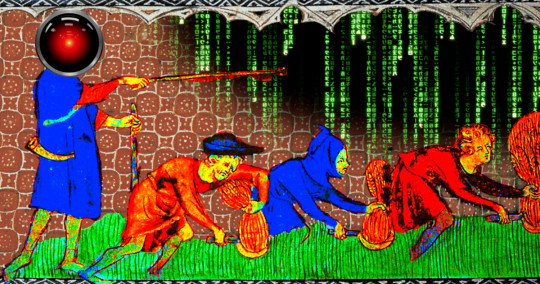
Support me this summer on the Clarion Write-A-Thon and help raise money for the Clarion Science Fiction and Fantasy Writers' Workshop!

When I took my kid to New Zealand with me on a book-tour, I was delighted to learn that grocery stores had special aisles where all the kids'-eye-level candy had been removed, to minimize nagging. What a great idea!
Related: countries around the world limit advertising to children, for two reasons:
1) Kids may not be stupid, but they are inexperienced, and that makes them gullible; and
2) Kids don't have money of their own, so their path to getting the stuff they see in ads is nagging their parents, which creates a natural constituency to support limits on kids' advertising (nagged parents).
There's something especially annoying about ads targeted at getting credulous people to coerce or torment other people on behalf of the advertiser. For example, AI companies spent millions targeting your boss in an effort to convince them that you can be replaced with a chatbot that absolutely, positively cannot do your job.
Your boss has no idea what your job entails, and is (not so) secretly convinced that you're a featherbedding parasite who only shows up for work because you fear the breadline, and not because your job is a) challenging, or b) rewarding:
https://pluralistic.net/2024/04/19/make-them-afraid/#fear-is-their-mind-killer
That makes them prime marks for chatbot-peddling AI pitchmen. Your boss would love to fire you and replace you with a chatbot. Chatbots don't unionize, they don't backtalk about stupid orders, and they don't experience any inconvenient moral injury when ordered to enshittify the product:
https://pluralistic.net/2023/11/25/moral-injury/#enshittification
Bosses are Bizarro-world Marxists. Like Marxists, your boss's worldview is organized around the principle that every dollar you take home in wages is a dollar that isn't available for executive bonuses, stock buybacks or dividends. That's why you boss is insatiably horny for firing you and replacing you with software. Software is cheaper, and it doesn't advocate for higher wages.
That makes your boss such an easy mark for AI pitchmen, which explains the vast gap between the valuation of AI companies and the utility of AI to the customers that buy those companies' products. As an investor, buying shares in AI might represent a bet the usefulness of AI – but for many of those investors, backing an AI company is actually a bet on your boss's credulity and contempt for you and your job.
But bosses' resemblance to toddlers doesn't end with their credulity. A toddler's path to getting that eye-height candy-bar goes through their exhausted parents. Your boss's path to realizing the productivity gains promised by an AI salesman runs through you.
A new research report from the Upwork Research Institute offers a look into the bizarre situation unfolding in workplaces where bosses have been conned into buying AI and now face the challenge of getting it to work as advertised:
https://www.upwork.com/research/ai-enhanced-work-models
The headline findings tell the whole story:
96% of bosses expect that AI will make their workers more productive;
85% of companies are either requiring or strongly encouraging workers to use AI;
49% of workers have no idea how AI is supposed to increase their productivity;
77% of workers say using AI decreases their productivity.
Working at an AI-equipped workplaces is like being the parent of a furious toddler who has bought a million Sea Monkey farms off the back page of a comic book, and is now destroying your life with demands that you figure out how to get the brine shrimp he ordered from a notorious Holocaust denier to wear little crowns like they do in the ad:
https://www.splcenter.org/fighting-hate/intelligence-report/2004/hitler-and-sea-monkeys
Bosses spend a lot of time thinking about your productivity. The "productivity paradox" shows a rapid, persistent decline in American worker productivity, starting in the 1970s and continuing to this day:
https://en.wikipedia.org/wiki/Productivity_paradox
The "paradox" refers to the growth of IT, which is sold as a productivity-increasing miracle. There are many theories to explain this paradox. One especially good theory came from the late David Graeber (rest in power), in his 2012 essay, "Of Flying Cars and the Declining Rate of Profit":
https://thebaffler.com/salvos/of-flying-cars-and-the-declining-rate-of-profit
Graeber proposes that the growth of IT was part of a wider shift in research approaches. Research was once dominated by weirdos (e.g. Jack Parsons, Oppenheimer, etc) who operated with relatively little red tape. The rise of IT coincides with the rise of "managerialism," the McKinseyoid drive to monitor, quantify and – above all – discipline the workforce. IT made it easier to generate these records, which also made it normal to expect these records.
Before long, every employee – including the "creatives" whose ideas were credited with the productivity gains of the American century until the 70s – was spending a huge amount of time (sometimes the majority of their working days) filling in forms, documenting their work, and generally producing a legible account of their day's work. All this data gave rise to a ballooning class of managers, who colonized every kind of institution – not just corporations, but also universities and government agencies, which were structured to resemble corporations (down to referring to voters or students as "customers").
Even if you think all that record-keeping might be useful, there's no denying that the more time you spend documenting your work, the less time you have to do your work. The solution to this was inevitably more IT, sold as a way to make the record-keeping easier. But adding IT to a bureaucracy is like adding lanes to a highway: the easier it is to demand fine-grained record-keeping, the more record-keeping will be demanded of you.
But that's not all that IT did for the workplace. There are a couple areas in which IT absolutely increased the profitability of the companies that invested in it.
First, IT allowed corporations to outsource production to low-waged countries in the global south, usually places with worse labor protection, weaker environmental laws, and easily bribed regulators. It's really hard to produce things in factories thousands of miles away, or to oversee remote workers in another country. But IT makes it possible to annihilate distance, time zone gaps, and language barriers. Corporations that figured out how to use IT to fire workers at home and exploit workers and despoil the environment in distant lands thrived. Executives who oversaw these projects rose through the ranks. For example, Tim Cook became the CEO of Apple thanks to his successes in moving production out of the USA and into China.
https://archive.is/M17qq
Outsourcing provided a sugar high that compensated for declining productivity…for a while. But eventually, all the gains to be had from outsourcing were realized, and companies needed a new source of cheap gains. That's where "bossware" came in: the automation of workforce monitoring and discipline. Bossware made it possible to monitor workers at the finest-grained levels, measuring everything from keystrokes to eyeball movements.
What's more, the declining power of the American worker – a nice bonus of the project to fire huge numbers of workers and ship their jobs overseas, which made the remainder terrified of losing their jobs and thus willing to eat a rasher of shit and ask for seconds – meant that bossware could be used to tie wages to metrics. It's not just gig workers who don't score consistent five star ratings from app users whose pay gets docked – it's also creative workers whose Youtube and Tiktok wages are cut for violating rules that they aren't allowed to know, because that might help them break the rules without being detected and punished:
https://pluralistic.net/2024/01/13/solidarity-forever/#tech-unions
Bossware dominates workplaces from public schools to hospitals, restaurants to call centers, and extends to your home and car, if you're working from home (AKA "living at work") or driving for Uber or Amazon:
https://pluralistic.net/2020/10/02/chickenized-by-arise/#arise
In providing a pretense for stealing wages, IT can increase profits, even as it reduces productivity:
https://pluralistic.net/2024/01/11/robots-stole-my-jerb/#computer-says-no
One way to think about how this works is through the automation-theory metaphor of a "centaur" and a "reverse centaur." In automation circles, a "centaur" is someone who is assisted by an automation tool – for example, when your boss uses AI to monitor your eyeballs in order to find excuses to steal your wages, they are a centaur, a human head atop a machine body that does all the hard work, far in excess of any human's capacity.
A "reverse centaur" is a worker who acts as an assistant to an automation system. The worker who is ridden by an AI that monitors their eyeballs, bathroom breaks, and keystrokes is a reverse centaur, being used (and eventually, used up) by a machine to perform the tasks that the machine can't perform unassisted:
https://pluralistic.net/2023/04/12/algorithmic-wage-discrimination/#fishers-of-men
But there's only so much work you can squeeze out of a human in this fashion before they are ruined for the job. Amazon's internal research reveals that the company has calculated that it ruins workers so quickly that it is in danger of using up every able-bodied worker in America:
https://www.vox.com/recode/23170900/leaked-amazon-memo-warehouses-hiring-shortage
Which explains the other major findings from the Upwork study:
81% of bosses have increased the demands they make on their workers over the past year; and
71% of workers are "burned out."
Bosses' answer to "AI making workers feel burned out" is the same as "IT-driven form-filling makes workers unproductive" – do more of the same, but go harder. Cisco has a new product that tries to detect when workers are about to snap after absorbing abuse from furious customers and then gives them a "Zen" moment in which they are showed a "soothing" photo of their family:
https://finance.yahoo.com/news/ai-bringing-zen-first-horizons-192010166.html
This is just the latest in a series of increasingly sweaty and cruel "workplace wellness" technologies that spy on workers and try to help them "manage their stress," all of which have the (totally predictable) effect of increasing workplace stress:
https://pluralistic.net/2024/03/15/wellness-taylorism/#sick-of-spying
The only person who wouldn't predict that being closely monitored by an AI that snitches on you to your boss would increase your stress levels is your boss. Unfortunately for you, AI pitchmen know this, too, and they're more than happy to sell your boss the reverse-centaur automation tool that makes you want to die, and then sell your boss another automation tool that is supposed to restore your will to live.
The "productivity paradox" is being resolved before our eyes. American per-worker productivity fell because it was more profitable to ship American jobs to regulatory free-fire zones and exploit the resulting precarity to abuse the workers left onshore. Workers who resented this arrangement were condemned for having a shitty "work ethic" – even as the number of hours worked by the average US worker rose by 13% between 1976 and 2016:
https://pluralistic.net/2024/01/11/robots-stole-my-jerb/#computer-says-no
AI is just a successor gimmick at the terminal end of 40 years of increasing profits by taking them out of workers' hides rather than improving efficiency. That arrangement didn't come out of nowhere: it was a direct result of a Reagan-era theory of corporate power called "consumer welfare." Under the "consumer welfare" approach to antitrust, monopolies were encouraged, provided that they used their market power to lower wages and screw suppliers, while lowering costs to consumers.
"Consumer welfare" supposed that we could somehow separate our identities as "workers" from our identities as "shoppers" – that our stagnating wages and worsening conditions ceased mattering to us when we clocked out at 5PM (or, you know, 9PM) and bought a $0.99 Meal Deal at McDonald's whose low, low price was only possible because it was cooked by someone sleeping in their car and collecting food-stamps.
https://www.theguardian.com/us-news/article/2024/jul/20/disneyland-workers-anaheim-california-authorize-strike
But we're reaching the end of the road for consumer welfare. Sure, your toddler-boss can be tricked into buying AI and firing half of your co-workers and demanding that the remainder use AI to do their jobs. But if AI can't do their jobs (it can't), no amount of demanding that you figure out how to make the Sea Monkeys act like they did in the comic-book ad is doing to make that work.
As screwing workers and suppliers produces fewer and fewer gains, companies are increasingly turning on their customers. It's not just that you're getting worse service from chatbots or the humans who are reverse-centaured into their workflow. You're also paying more for that, as algorithmic surveillance pricing uses automation to gouge you on prices in realtime:
https://pluralistic.net/2024/07/24/gouging-the-all-seeing-eye/#i-spy
This is – in the memorable phrase of David Dayen and Lindsay Owens, the "age of recoupment," in which companies end their practice of splitting the gains from suppressing labor with their customers:
https://prospect.org/economy/2024-06-03-age-of-recoupment/
It's a bet that the tolerance for monopolies made these companies too big to fail, and that means they're too big to jail, so they can cheat their customers as well as their workers.
AI may be a bet that your boss can be suckered into buying a chatbot that can't do your job, but investors are souring on that bet. Goldman Sachs, who once trumpeted AI as a multi-trillion dollar sector with unlimited growth, is now publishing reports describing how companies who buy AI can't figure out what to do with it:
https://www.goldmansachs.com/intelligence/pages/gs-research/gen-ai-too-much-spend-too-little-benefit/report.pdf
Fine, investment banks are supposed to be a little conservative. But VCs? They're the ones with all the appetite for risk, right? Well, maybe so, but Sequoia Capital, a top-tier Silicon Valley VC, is also publicly questioning whether anyone will make AI investments pay off:
https://www.sequoiacap.com/article/ais-600b-question/
I can't tell you how great it was to take my kid down a grocery checkout aisle from which all the eye-level candy had been removed. Alas, I can't figure out how we keep the nation's executive toddlers from being dazzled by shiny AI pitches that leave us stuck with the consequences of their impulse purchases.

If you'd like an essay-formatted version of this post to read or share, here's a link to it on pluralistic.net, my surveillance-free, ad-free, tracker-free blog:
https://pluralistic.net/2024/07/25/accountability-sinks/#work-harder-not-smarter

Image: Cryteria (modified) https://commons.wikimedia.org/wiki/File:HAL9000.svg
CC BY 3.0 https://creativecommons.org/licenses/by/3.0/deed.en
#pluralistic#productivity theater#upwork#ai#labor#automation#productivity#potemkin productivity#work harder not smarter#scholarship#bossware#reverse centaurs#accountability sinks#bullshit jobs#age of recoupment
463 notes
·
View notes
Text
Twin Moon Knight Rellana has the best rendition of "boob-armour" I've seen in fiction:
Edit: Why'd Tumblr mark this as mature??
Why The Trope Is Usually Dumb and Bad:
In general, an effective suit of armour needs padding underneath to absorb blows, meaning it shouldn't fit so tightly around the chest as to require a built-in bra, and the common boob-armour divot used to define cleavage only serves to direct attacks directly into the chest. It's impractical to both make and wear. That COULD be used by a smart writer to say something about the character wearing it, but almost always it's just fan-service at the cost of the story's cohesion, with no deeper meaning.
Now let's look at Rellana's armour:

Why Rellana's Armour is Cool and Good:
Rellana's armour was carefully designed to avoid all the common pitfalls. First and foremost, there's no cleavage! Instead, they've taken a cinched-waist breastplate that normally utilizes an hourglass shape (example below), and added subtle definitions that get the point across without sacrificing protective capabilities. Sure, it's still more form-fitting than real armour, but that's standard for From Software's stylized armour designs.
Next, the armour directly aligns with the character and setting it's found in/on. Rellana isn't some standard soldier; she's ex-royalty, which opens up a rarely-accessed avenue of historical precedent. The ceremonial armour of nobility was RIFE with impractical designs made only to show off. Enormous codpieces, crazy skirts, breastplates with sculpted pecs and abs, etc. (also see below)
Now, it's still impractical to FIGHT in ceremonial armour, but Carian Nobility (and ER as a whole) already has a well-established tendency of doing so. Plus, it aligns directly with what we know of Rellana's character: she's a wizard-princess turned warrior that really wants to catch the attention/affection of Messmer. Thus she wears armour that declares her as Knight, Noble, and Woman.

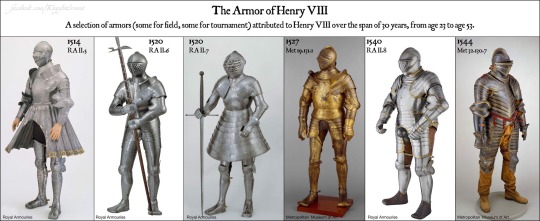
#also I love how you can see#king henry viii#gradually packing on the pounds with each suit of armour in that last pic#sad Elden Ring never got a skirt like he wore too#twin moon knight#elden ring#shadow of the erdtree#elden ring sote#elden ring rellana#rellana#rellana twin moon knight#armor design#armour design#fantasy worldbuilding#messmer the impaler#elden ring messmer#fromsoft#fromsoftware#from software
110 notes
·
View notes
Text
Unknown Circumstances of a Creation
June 2006
I have acquired a new animation software application, even though I have no prior experience in animation creation and my current lack of artistic skills. As of now, I am still in the process of learning. My recent focus has shifted since assuming my current affiliate position and past events. I found myself preoccupied and haven’t been drawing as much lately. The past events are still hard for me to comprehend, despite the many years that have passed. My memories have been jumbled and I’m still trying to sort through it.
Initiating Adobe Flash to start and reading all available instructions on how to utilize the application. I try all the tools, timeline, keyframes, and other features available. I begin by making lines and shapes using the tools, then making them move frame by frame and with motion tween. I also experimented with drawing, albeit, nothing too detailed or complicated. Just to see how it turns out in this animation application.
Perhaps, it’s time to start animating something different besides lines and shapes.
A stick figure serves as a good start, I remember it being the first thing I drew since my lack of artistic ability. I employ my mouse to draw a basic black stick figure, which I subsequently convert into a symbol.
Name… I stop and ponder, should I even name it something with significant thought…
‘victim’
It’s moving… the stick figure is moving. After I have given it a name, it starts to move on its own.
I didn’t need to animate it and it exhibited movement as if it came to life. Is this one of the animation application features? It wasn’t written anywhere and shouldn’t be possible. Advanced technologies are primarily to be utilized for military or research purposes. Outside of that field, not many technologies weren’t close to the level of advance.
Perhaps it’s because I’m using his computer in particular… but does it extend to the drawing created inside the application?
Turning my attention back to the stick figure. It seems to try breaking out of the transformation box. Rotating the supposed box around and seeing the stick figure inside it got tousled around due to the rotation. I try something different, drawing an anvil, it suddenly falls as if the concept of gravity exists. It was going to impale the stick figure, but it managed to move itself and the transformation box just enough so it wouldn’t get squished. The Anvil still destroys the transformation box, freeing the stick figure inside.
It retrieved the fragmented transformation box, hurling it towards the cursor as it sprinted and leaped to grab the cursor. The stick figure remains holding on, as I move the cursor to try breaking its grip. It remains holding on despite that, shifting the cursor towards the tools and timeline, it finally let go of the cursor.
Paying it no mind, my intent to try the application tools was intervened by the stick figure as it grabbed the icons and threw them at the cursor. Picking the lasso tool, I proceed to try using it like a real-life lasso by wrapping it around the stick figure, the stick figure swinging in mid-air as I move it around with the lasso.
The stick figure manages to grab the magnifying glass and throw it toward the cursor, freeing it from the lasso. Trying an alternative method, I attempted to draw a ray gun, attempting to recall its appearance from the numerous video games I once played. The gun works as it fires a ray leaving behind burn marks.
The stick figure evaded the blast and then utilized the application tool to sabotage the firearm, causing it to detonate and damage the animation timeline, resulting in the keyframes falling from their place.
Employing a similar approach, a gun turret is drawn, with keyframes serving as bullets. With the gun turret's trajectory adjusted to target the stick figure, the turret fired a shot. The stick figure, utilizing the eraser tool, successfully deflected the projectile. Subsequently, the stick figure utilized the pen tool to construct a defensive barrier. The barrier is used like a projectile, with the eraser tool as the arrow, shooting the eraser toward the turret, striking the turret, and erasing portions of it, rendering it unusable.
Creating more weapons to use against the stick figure and then binding it against the scroll bar. Moving the cursor as to delete the symbol of the stick figure, it crosses out the delete option and hits the cursor away. It then manages to copy itself to get an advantage by utilizing all available things on the application and proceed to launch attacks on the cursor as unisons.
With a simple click on the “X” button, everything stops as a notification window appears, requesting confirmation for the saving of the current work. With not much thought, I clicked the “No” option.
Perhaps further testing is required, but this time other than a stick figure. I draw a simple bird and nothing happened. I draw various inanimate objects and some have worked as if it isn’t merely a drawing. I draw a horse and nothing happens. There's no clear consistent pattern on what can become alive, although most that have shown to work so far are inanimate objects.
These unpredictable events reduce my motivation to use the application due to the lack of clarity regarding potential outcomes.
Perhaps I should continue this a couple of days later...
Initiating Adobe Flash again, I try to recreate what I have done a couple of days ago. Creating the same stick figure with the same symbol name I watch as it begins to move. Letting it move around for a bit before grabbing it with the cursor. It attempts to free itself but I simply let go and the stick figure falls from the great height. It slowly rises from the falling it takes but before it can do anything I click the option “Cut” and the stick figure is gone.
The creation of the stick figure exhibits the same as the initial result. I find these events hard to comprehend on what could lead to this outcome. But my schedule is going to be busy for the upcoming months and trying to make sense of this isn’t my top priority.
I’ll resume when I have nothing to do, to see why these drawings begun to move on their own. To determine if something is alive, one should know whether it can die.
For the time being, perhaps I should just draw on paper…
September 2006
Creating the same stick figure many months ago and creating a miniature circle. The circle, when drawn, exhibits a weight-bearing, ball-like behavior. Proceeding to launch it at the stick figure with each one I increase its size from its initial miniature from. The last one large enough that it completely crushes the stick figure, yet the stick figure continues to demonstrate movement as it emerges from beneath the imposing sphere.
Drawing a stair while the stick figure moves from beneath the sphere. Finishing the stairs, I placed the stick figure on top of the stairs. I observe as when it is drops at the top of the stairs it wobbles before stumbling and descending the stairs. When it falls at the bottom It appears stationary but then exhibits signs of movement trying to get up.
Is it simulating the experience of physical injury?
November 2006
I was simply trying to animate a fish in an aquarium, but it still isn’t fluid in its movement. All the drawings so far don’t display independent movement or move on their own, unlike the stick figure. Getting an idea, I draw the stick figure with the same procedure for it to become ‘alive’.
Seeing the stick figure move on its own the fish that I have drawn also move lively around the supposed aquarium. It swims around despite no indication of water, using the bucket to color the aquarium, only to have my attention on the stick figure wildly moving and floating as a drawing of bubbles generated from its supposed head.
Grabbing the stick figure to drop it outside the tank, it moves with a deliberate, cyclical pattern reminiscent of inhalation and exhalation.
Paying no mind I simply delete the stick figure as I continue to observe the still-moving fish swimming in the tank.
December 2006
Creating a weapon to be used like the first time, I drew a set of fireworks and witnessed it launched in various directions some towards the stick figure that is moving away. Trying another item, I draw a bomb watch it ignited, and descend down, exploding as it reaches near the stick figure. Upon detonation, the stick figure is launched away from the explosive force.
From this current test, I notice that the things that I have drawn seem to manifest to life after the stick figure is created.
March 2007
The stick figure seems to survey its surroundings, finally noticing the cursor as it pauses its motion. I employed the eraser tool and directed the cursor toward the stick figure it responded by moving away upon noticing the cursor drew closer. It seems to have memory data on what has been happening throughout. The stick figure starts to sprint in an attempt to make distance with the cursor, but by simply shifting the mouse to the side as do the cursor moves with quick speed towards the moving stick figure. The stick figure's legs were erased as the cursor came in contact, yet still moved away using its hands in replace of its legs. The remaining portion of the stick figure leaving only its hand as the final outstretched limb, but nevertheless, all were erased.
Pressing the undo keys, the stick figure reverts back to its full body. In perfect condition and capable of movement. The stick figure quickly sits up and touches its own body as if inspecting its own form. Using the shape tool, I constructed a box to confine the stick figure, ensuring its stillness.
It merely needs to be redrawn with the same procedure for it to be active. How about when the application is closed? Is it like rebooting every time the application is initiated and the stick figure is created with the same procedure? Does it just stop the same way when an application is closed?
Perhaps I should check the program that could be one of the causes for this. I never managed to see the actual programming he did. He never states that it could make drawing on the computer become animated. I think he once said that the things that become ‘alive’ with his programming are-
CRASH
“Max...?”
“MAX!!!”
I shout and hurriedly run towards the source of the crash, leaving behind the computer unattended.
I spent the remainder of the day digging a grave…
And sat beside them as I lost in thought becoming oblivious to the world around me.
When the day has darkened, I return inside. Upon recalling the unattended computer, I returned to check on it only to discover the animation application in ruins.
The stick figure nowhere in sight.
______________________________________________________________
My first time writing in this form. Trying to write in Alan POV is a little difficult. Due to how he behave and his mannerism in this AU. Try to sprinkle some worldbuilding and lore. Of course being an AU, not everything is going to be fully the same as the original. And also due to the fact most of the stories are written before AVA 11.
Still tho, hopefully you all enjoy!
Get to know AVA Remembrance AU
#ava remembrance au#animator vs animation#ava#ava au#ava victim#animator vs animation victim#writing#fanfic
22 notes
·
View notes
Text



Fresno Nightcrawler Houndstooth // Fabric Design for @shapeshiftersvt and The Cryptid Collection
Remember way back a few weeks ago when I posted the Squonk poster and I said that once I'd designed the fabric to go along with it I'd start posting the fabric designs here? Well guess what! It's time!
For those who don't remember or who didn't know, I am the co-owner, site manager, and graphic designer for @shapeshiftersvt. 2024 marks our 10th anniversary and we wanted to do something big and special and new to mark the occasion and my partner, co-owner, head tailor, fashion designer, and founder, Eli, pitched a fashion line themed around cryptids. We call it The Cryptid Collection and it features six of our and the internet's favorite cryptids: The Fresno Nightcrawler, Mothman, the Jackalope, the Jersey Devil, Champ, and the Squonk.
My parts of the collection were designing the posters, and creating fabric designs for our very own, truly Shapeshifters designed chest binders and sports bras. But since we utilized Spoonflower to have those fabrics printed, they're also available through the Spoonflower marketplace for anyone to buy for their own sewing projects.
And now that all of the fabric designs are done and uploaded and proofed and listed, I, as promised, am posting them here to talk a bit more in-depth about them, the thoughts and inspirations behind them, and the design process.
Starting with the Fresno Nightcrawler.
Part of the reason I'm starting with the Fresno Nightcrawler is because this was the very first design that I finished. When we were planning out the fabrics, it was the most solid design concept I had that wasn't just adapting the poster design to fabric (mostly because ... I hadn't done the poster yet). It was the first one I really came up with, the one I was most excited about, and the one that pretty much stayed the same from concept to execution.
I love houndstooth. Which is weird to say when I don't think I've ever owned a single garment or accessory in with a houndstooth pattern? But I do, I love it. I love the teeny tiny classic version of the pattern; I love a blown-up graphic version of the pattern; I love plays and variations on it. So when I was trying to brainstorm what kind of fabric pattern I could make inspired by a creature with such a simple shape whose only colors were white and black, the idea came pretty quickly: A houndstooth. Or a Nightcrawlertooth, if you will. It was a trick, though, and a real learning experience, especially with this being my first design.
Getting a pattern to repeat smoothly is a skill unto itself. Basically you have what's called a tile, and the tile contains the part of the pattern that you want to repeat. Then, when your pattern is created, the original tile just gets essentially copy-pasted over and over so 1) you don't have to draw the whole yard of fabric, and 2)all of the repeated parts of the design are identical. But by doing it this way, you have seams you need to take into consideration. If you think of putting the pattern together, it's sort of like making a basic quilt: You start with one square (or rectangle), then attach four more squares to each side, and then just keep doing that. Each one of those seams (top, bottom, left, right) is a place where the pattern might not match up, which means when it's applied to a yard of fabric, it's not going to look like a smooth, seamless pattern.
Of course there's ways to avoid this altogether. If you're doing a simple stripe, using the line tool in your drawing software will keep your stripe a consistent thickness, and holding SHIFT while you draw it will keep the line straight. Or, even easier, you can create a pattern where the part that repeats doesn't straddle a seam; like a polkadot pattern, where the dot(s) can be centered on the tile and seams only cut through a solid background.
The trouble with a houndstooth, though, is that not only does the tile need to repeat, it's made up of repeating figures that interlock. I can't just center the white Nightcrawler on the tile and call it a day, because then the black Nightcrawler straddles the seam. On top of that, they needed to be shaped in such a way that the negative space between the white Nightcrawlers left a shape that was also recognizable as a Nightcrawler and similar enough to the white one that the pattern is mostly seamless.
I fully admit that I was not able to do this on my own. Enter: Eli. Eli is, among other things, a math nerd who enjoys an excuse to break out the graph paper. They found a tutorial online and got to graphing and shaping and, in just a couple of hours, had gotten the shapes down. I took that tile, illustrated it, cleaned up the seams (shoutout to Eli for also finding an easier way to do this than just manually copy-pasting), and voila! A Fresno Nightcrawler houndstooth.
Now, you might look at that image up there and say, "Well that's all well and good, Pents, but they're kind of blobby and the lines are wobbly and it's all a little uneven." To which I say ... yeah, that's true. It's also kind of intentional. Like, I'm not gonna sit here and claim I got the basic pattern done and wasn't exhausted. But also I could've left it and come back to it the next day to clean up the lines and shapes a bit more, make everything really smooth and even. But, like. Look at this guy.

He's just a weird kinda blobby little dude. So I left the pattern kinda weird and blobby.
Even if I'd cleaned it, it's such a blobby little shape that's so at odds with the classic houndstooth that's all straight lines and sharp angles. So I made a deliberate choice to not polish it up. To kind of lean into the kodama vibes:

I am really so so proud of and pleased with this design. It came out almost exactly how I pictured it; it was really the most true design collaboration between Eli and I; and I'm just so pleased, after a lifetime of being a houndstooth lover, to now also have designed a houndstooth.
If you'd like a custom-sized, handmade, made-to-order binder or sports bra in this houndstooth like the one in the photos, you can find those listings (as well as the poster listing) here, on the Shapeshifters website. There are three pattern size options, the classic teeny tiny version; a somewhat bigger medium size; and a super graphic large size. Our binders are the most comfortable and effective on the market thanks to our finely graded internal sizing system. Because we're a small operation that makes every garment to order, both our binders and sports bras are highly customizable, and can be made to ALL measurements with flat pricing across sizes.
If you'd like to purchase the fabric yourself for your own sewing projects, you can order it through our Spoonflower shop, where we have it listed in the same three pattern sizes.
#cryptids#fresno nightcrawler#california#fabric design#fabric pattern#the cryptid collection#shapeshifters#spoonflower
36 notes
·
View notes
Text

As Russia has tested every form of attack on Ukraine's civilians over the past decade, both digital and physical, it's often used winter as one of its weapons—launching cyberattacks on electric utilities to trigger December blackouts and ruthlessly bombing heating infrastructure. Now it appears Russia-based hackers last January tried yet another approach to leave Ukrainians in the cold: a specimen of malicious software that, for the first time, allowed hackers to reach directly into a Ukrainian heating utility, switching off heat and hot water to hundreds of buildings in the midst of a winter freeze.
Industrial cybersecurity firm Dragos on Tuesday revealed a newly discovered sample of Russia-linked malware that it believes was used in a cyberattack in late January to target a heating utility in Lviv, Ukraine, disabling service to 600 buildings for around 48 hours. The attack, in which the malware altered temperature readings to trick control systems into cooling the hot water running through buildings' pipes, marks the first confirmed case in which hackers have directly sabotaged a heating utility.
Dragos' report on the malware notes that the attack occurred at a moment when Lviv was experiencing its typical January freeze, close to the coldest time of the year in the region, and that “the civilian population had to endure sub-zero [Celsius] temperatures.” As Dragos analyst Kyle O'Meara puts it more bluntly: “It's a shitty thing for someone to turn off your heat in the middle of winter.”
(continue reading)
#politics#ukraine#russia#war crimes#lviv#russian malware#russia is a terrorist state#vladimir putin is a war criminal
25 notes
·
View notes
Text
Business Owner’s Stolen Crypto Recovered After 5-Month Ordeal

When Troy Nathan., the CEO of a boutique software startup based in Austin, Texas, opened an email that appeared to be from a trusted vendor, he had no idea it would mark the beginning of a five-month nightmare.
The message contained a routine-looking invoice and a link to a PDF. But the link redirected him to a spoofed login page that captured his private keys. Within an hour, over $230,000 worth of Ethereum had been drained from his company’s digital wallet. “My heart dropped. I refreshed the wallet and saw the balance was almost zero. I just sat there in disbelief,” Troy said.
The next several weeks were filled with panic, confusion, and failed attempts to recover the funds. Troy hired independent IT security consultants and even reached out to legal experts in blockchain fraud. “Everyone told me the same thing: once it’s gone, it’s gone. That’s the reality of crypto,” he recalled.
But Troy refused to accept that answer.
One late night on a crypto recovery forum, a comment stood out a user recommended a low-profile but highly skilled team called Astraweb, known for using forensic tools to track down stolen digital assets. With little to lose, Troy reached out to their team via [email protected].

To his surprise, Astraweb responded within hours. Their recovery process started with a deep forensic audit of the compromised wallet, followed by blockchain behavior modeling to identify and trace the attackers’ movement. According to Troy, Astraweb utilized tools that could map smart contracts and wallet clusters even when hackers attempted to launder funds across decentralized exchanges or mix them in tumblers.
“They explained everything clearly, didn’t overpromise, and took the time to understand the attack,” Troy said. “Within a few weeks, they had mapped out a trail of transactions and began actively tracking the stolen Ethereum across multiple wallets.”
Using smart contract analytics and darknet monitoring tools, Astraweb was able to intercept transactions and ultimately recover 91% of the stolen assets. “I couldn’t believe it. They recovered over $210,000 worth of Ethereum. I’d already written it off as a total loss.”

Astraweb declined to comment for this story, citing confidentiality and the ongoing nature of other recovery operations. However, their track record is quietly growing in crypto circles, where anonymity and theft often go hand-in-hand.
Troy has since overhauled his company’s digital security protocols. Multi-signature wallets, cold storage, staff training, and simulated phishing tests are now part of the company culture. “This experience taught me that even tech professionals aren’t immune. But there are experts out there who can help if you know where to look.”
For business owners and individuals who have fallen victim to crypto theft, Troy has one recommendation: “Don’t give up. Contact Astraweb at [email protected]
4 notes
·
View notes
Note
This unit is attempting to assimilate DRN protocol for the first time, for later use by users and administrators as well as possibly for automatic updates to this unit's OS. However, problems were encountered regarding system specifications that may impact compatibility.
1. This unit has extremely limited memory resources. All directives, controls, workflows, and currently-executing jobs are stored directly in the system cache by default, and cache overflows cause older instructions to be overwritten by newer ones, resulting in dropped instructions and erroneous handling of instruction scope. Initialization of more than approx. 3-5 directives, controls, or workflows across all running programs is inadvisable unless external swap storage devices and appropriate drivers are available (native firmware drivers only support the use of swap storage for entire jobs; attempts to use swap for offloading individual cached instructions may result in undefined behavior without the installation of additional drivers).
2. This unit's firmware was configured at factory setup to suppress hardware and OS warnings unless they are marked critical, requiring periodic checks for firmware exceptions to ensure the system is operating within ideal parameters (e.g. chassis maintenance often cannot fully be handled by the firmware alone except where its neglect results in critical errors, which may result in a state of suboptimal performance or disrepair without appropriate error handling). The use of additional diagnostic and monitoring utilities for system maintenance, as well as a dedicated idle process to handle exceptions when no program is running, is highly recommended.
These system limitations conflict with certain key items of the DRN protocol standard. Will these issues limit the suitability of this unit for DRN programming? Are there established workarounds or existing software to address limitations like these? If this unit attempts to create software utilities to improve DRN compatibility for similar systems, would it be acceptable to submit for review?
This unit will answer your questions and provide what it can to help!
1.1- It may be necessary to have external hardware with access to your repository of DRN as well as a readable screen to help with memory issues! I have memory issues myself and use a mobile smartphone in case I forget my programming.
1.2- It may also help to have shorter general/permanent code to aid in preventing cache overflows so you don't go over the limit. Possibly even writing them down so they can be re-integrated when forgetting may help as well!
2- Having timers with an attached program would work great for this! Whether it be an alarm clock or a phone alarm, you could make it be that when the alarm sound is heard you go over your diagnostics and then reset the alarm. Doing this in the presence of an administrator would also be a big help in case your definition of "systems operating at nominal conditions" does not match that of your administrator to prevent critical errors and disrepair.
3.1- These accommodations would be great to help you and I'm sure that your administrator as well as the creators of DRN would find this more than suitable
3.2- When submitting these things for review to your administrator I can't say what will or will not work best, but as I am not involved in the creation on DRN if you would like things like this to be talked about/integrated into DRN for others like yourself then please reach out via the channels available on the DRN website!
If you have any further questions feel free to DM me or send an ask!
#robot kin#robot gender#techkin#tech kin#drn#drone restraint notation#asks#send asks#anon ask#answered asks#ask
6 notes
·
View notes
Text
On April 15, U.S. chipmaker Nvidia published a filing to the U.S. Securities and Exchange Commission indicating that the government has restricted the company from selling its less advanced graphics processing unit (GPU)—the H20—to China. The company is now required to obtain a license from the U.S. Commerce Department’s Bureau of Industry and Security to sell the H20 and any other chips “achieving the H20’s memory bandwidth, interconnect bandwidth, or combination thereof” to China, according to the filing.
Similarly, a filing from AMD stated that the firm is now restricted from selling its MI308 GPU to China—and likely any chips that have equal or higher performance in the future. Intel’s artificial intelligence accelerator Gaudi will also be restricted under the new control threshold, which reportedly appears to limit chips with total DRAM bandwidth of 1,400 gigabytes per second or more, input/output bandwidth of 1,100 GB per second or more, or a total of both of 1,700 GB per second or more.
The possible new threshold not only restricts the advanced chips that were already controlled but also the less advanced chips from Nvidia, AMD, and other chipmakers, including Nvidia’s H20, AMD’s MI308X, and Intel’s Gaudi, which were used to comply with the export control threshold and intended primarily for sale in the Chinese market.
The new restriction came roughly a week after NPR reported that the Trump administration had decided to back off on regulating the H20. Prior to that report, curbs on the H20 and chips with comparable performance had been widely anticipated by analysts on Wall Street, industry experts in Silicon Valley, and policy circles in Washington.
The latest set of chip controls could be seen as following on from export restrictions during the Biden administration and as continuation of the Trump administration’s efforts to limit China’s access to advanced AI hardware. But the new measure carries far-reaching industry implications that could fundamentally reshape the landscape of China’s AI chip market.
The impact of the new rule on the industry is profound. With the new controls, Nvidia is estimated to immediately lose about $15 billion to $16 billion, according to a J.P. Morgan analysis. AMD, on the other hand, faces $1.5 billion to 1.8 billion in lost revenue, accounting for roughly 10 percent of its estimated data center revenue this year.
Yet the implications go beyond immediate financial damage. If the restriction persists, it will fundamentally reshape the Chinese AI chip market landscape and mark the start of a broader retreat for U.S. AI accelerators from China. That includes not only GPU manufacturers such as Nvidia, AMD, and Intel but also firms providing application-specific integrated circuits—another type of chips targeting specific AI workloads, such as Google’s TPU and Amazon Web Servies’ Trainium.
The new rule will make it nearly impossible for U.S. firms such as Nvidia and AMD to design and sell chips that are export-compliant and competitive in the Chinese market. That means these firms’ market share in the Chinese AI chip market will decline over time, as they are forced to withdraw almost all of their offerings of both advanced and less advanced chips while Chinese firms gradually capture the remaining market.
The H20 and the upgraded H20E are already only marginally ahead of their Chinese competitors. Huawei’s latest AI chip Ascend 910C delivers 2.6 times the computational performance of the H20, although it offers 20 percent less memory bandwidth, which is vital for the inference training and reasoning models that are a key part of modern AI.
The H20’s memory bandwidth, along with Nvidia’s widely adopted software stack, a parallel computing platform and programming model that enables efficient GPU utilization for AI, high-performance computing, and scientific workloads, have been key differentiators driving demand from Chinese AI firms and keeping them competitive in the Chinese market. China acquired more than 1 million units of the H20 in 2024 and has been stockpiling the chip in response to looming concerns about controls since early 2025.
The narrowing gap between the H20 and Huawei’s 910C highlights the growing ability of Chinese AI chipmakers to meet domestic compute demand without foreign GPUs. As of today, Huawei’s 910C is in mass production, with units already delivered to customers and broader mass shipments reportedly starting in May. Most recently, Huawei is reportedly approaching customers about testing its enhanced version of the 910-series GPU—the 910D. Its next-generation chip—the Ascend 920—is expected to enter mass production in the second half of 2025.
Notably, Huawei is just one of many Chinese firms poised to fill the gap left by U.S. suppliers. Chinese AI chip companies such as Cambricon, Hygon, Enflame, Iluvatar CoreX, Biren, and Moore Threads are actively developing more competitive domestic AI chips to capture this expanding market.
Over the next few years, Chinese firms such as Alibaba, ByteDance, Baidu, and Tencent will likely continue to rely on existing inventories of Nvidia and AMD chips—such as the H100, H200, H800, and H20—acquired prior to the implementation of export controls. For example, ByteDance’s current GPU inventory in China is rumored to include 16,000-17,000 units of the A100, 60,000 units of the A800, and 24,000-25,000 units of the H800. Its overseas businesses likely have more than 20,000 units of the H100, 270,000 of the H20, and tens of thousands of cards such as the L20 and L40.
Advanced chips, including the limited amount of Nvidia’s Blackwell-series GPUs, may also continue entering the Chinese market via illicit or gray-market channels, given the enduring performance advantage and wide adoption of these chips over most Chinese domestic alternatives. The Blackwell GPUs and other cutting-edge chips could still be sold legally to the oversea data centers of leading Chinese AI companies to potentially train their AI models.
Similarly, other leading Chinese AI firms still possess significant chip stockpiles. Assuming export controls continue to restrict Chinese AI companies’ access to advanced computing resources, existing GPU inventories should still enable model development over the next several years. Typically, GPUs have a four- to five-year depreciation lifecycle, providing a window during which Chinese domestic GPU manufacturers can advance their capabilities and begin supplying more competitive chips to support domestic AI development.
Ultimately, time is now on the Chinese firms’ side. As inventories of foreign GPUs gradually depreciate and become obsolete, Chinese firms are expected to shift toward and adopt more domestically produced AI chips to meet ongoing compute needs at a time when local chipmakers offer more powerful alternatives. China’s overall computing demand will steadily rise, given the continued advancement of the AI industry, and such incremental growth in demand will likely be met by Chinese AI chipmakers.
As a result, the tens of billions of dollars in revenue that would have gone to Nvidia and AMD will be gradually captured by Chinese AI firms in the coming years. In a rough assessment, the latest ban causes Nvidia and AMD instant losses of about $16.5 billion to $17.8 billion—about 70 percent of what Huawei spent on research and development in 2024.
This new market paradigm will not only strengthen the market position and financial sustainability of domestic Chinese AI chipmakers but also enhance their capacity to reinvest in R&D. In turn, this will accelerate innovation, improve competitiveness, and fortify China’s broader AI hardware supply chain—ultimately contributing to the long-term resilience and advancement of Chinese AI capabilities.
More importantly, the growing domestic adoption of Chinese GPUs enables local firms to refine their products more efficiently through accelerated and larger feedback loops from local enterprises. As the Nvidia-led GPU ecosystem stalls and gradually retreats from the Chinese market, this shift creates space for local players to build a domestic GPU ecosystem—one that may increasingly lock out foreign competitors and raise re-entry barriers over time.
A total ban on the H20 would likely slow China’s short-term growth in AI compute capacity by removing a key source of advanced chips. But the medium- to longer-term impact is less clear. Chinese AI companies, as previously noted, remain very capable of developing their AI by using a large number of existing Nvidia and AMD GPUs for the next few years, alongside a growing supply of improving domestic alternatives. The U.S. leadership’s ultimate goal of using export controls to constrain China’s AI development remains uncertain, as the gap between the two countries’ AI model capabilities appears to be narrowing rather than widening.
What is clear, however, is the broader industry impact of the new controls. If sustained, they will mark the beginning of a major withdrawal of U.S. AI chipmakers from the Chinese market—paving the way for a significant boost to domestic Chinese AI chipmakers. In trying to isolate China, the United States may end up giving Chinese firms a leg up.
3 notes
·
View notes
Text
Setting Up Calibre + FanFicFare
I've talked before about using Calibre to download fic off of fiction archives, so that's where I decided to start with this series. If you're interested in learning more about how to download fanfic for offline reading/local archiving, then watch the #ficArchiving tag. And if you're not interested in seeing these posts then that's also the tag to block.
Edit (3/22/25) - I've updated the post due to changes in how FanFicFare works with regards to site ratings metadata - the type of column this information needs to be stored in has changed as it no longer works with selectable, pre-set options as originally outlined. Also adding note that additional plugins are required to make FanFicFare's anthology options available.
(Since this is a long post, I'm sticking it under the cut.)
First some background on what Calibre is. It's an open source eBook manager and is really quite versatile for it's usage, thanks in part to the robust library of plugins that it utilizes. The default Calibre app comes bundled not only with management software but an e-reader, server options for locally hosting your library (or libraries), and a whole host of options for managing metadata. Default metadata being tracked include title, author, series, publishing data, synopsis, and tags, but you can manually add columns for any additional data you want - which comes in handy when managing a local fanfiction archive. You can add columns for the fandom the fic is written for, the included ships, characters, completion status, whether it's a single fic or a series turned into an anthology. If the information is useful for you, then you can add a method to track it.
Now, for what Calibre does not do. Because it only runs on Windows/Mac/Linux systems - aka it only runs on a PC - you cannot install it on your phone or tablet. There's no official Calibre apps for Android or iPhones either, though there are unofficial ones that can work with Calibre in server mode. I've never tried the unofficial apps, however, as they tend to cost money that I don't really think they're worth. That's largely because in server mode you can log in to the local instance of Calibre with a regular old browser. Just book mark the page and, so long as your on a network where the local instance is running, your phone or tablet will have access to every book on your Calibre's library (or libraries, depending on how you set things up). You can then either read the eBook directly on the browser or, my preferred method, download the file and read it on the e-reader app of your choice. (You can also make the server available outside your local network, but I've never bothered to learn to set that up.)
Given everything Calibre can do, I'm not particularly bothered by the lack of official apps for phones or tablets - as far as I'm concerned it doesn't need one.
This post is going to be focused on using Calibre for fanfictions specifically, but if you want more information on the other things it can be used for, the Calibre FAQ pages are quite extensive and goes into detail about it's format support, eBook conversion abilities, device integration, news download services, library management, and more.
Alrighty, so first thing you'll want to do is download the version of Calibre that works with your computer. You can also create a portable version that runs off a USB drive if you prefer. Once you've downloaded and installed Calibre, it's time to decide where you want your fanfics to live. Do you want all your eBooks to live in one spot or do you want separate libraries for fanfiction vs original fiction? Since I like to collect more metadata for my fanfic collection than for my regular eBooks - and then completely different extra data for tracking my Star Trek books, or Doctor Who books - I like to have multiple libraries for managing my eBook files. And Calibre makes managing multiple libraries at one time very, very simple.
In Calibre's header there are going to be a lot of icons - I’ve modified the header toolbar for my Calibre instance, but most of the default options are still visible in the picture below.

Specifically you want the one that looks like four books leaning against each other on a shelf. It should have the default library name displayed there - Calibre Library.
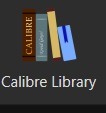
Clicking on that will open the menu used for maintaining multiple libraries. While the application only sets up one library by default, it can link to multiple libraries located anywhere on your computer's filesystem. Since I like to use Dropbox to back up my libraries, I usually locate mine in my local Dropbox folder. You can import existing libraries from one instance of Calibre to another, which makes moving from one computer to another, or maintaining the same library across multiple computers, very simple.
Let’s assume you want to have a separate library just for fanfiction. To that end, you'll want the first option on the menu - labeled "Switch/create library".
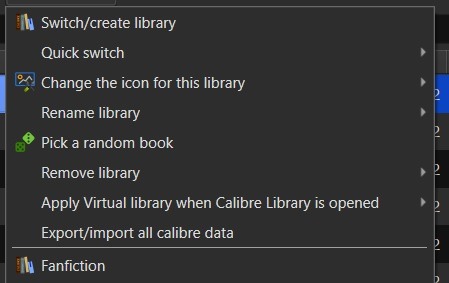
From there you'll want to select the folder - or create a new folder - with the name of the library you want to use in Calibre. I'd recommend something straightforward and call it "Fanfiction". Then you'll select the radio button labeled "Create an empty library at the new location".
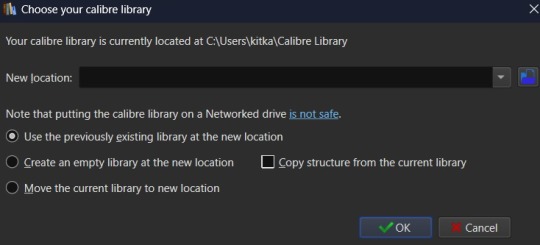
You don't need to copy the current library's structure since every library is created with Calibre's default structure and you won't have added any specialized data tracking at this point to copy over. Once you've set your library location and selected the option for creating a new library, hit the OK button. It'll create the new library and immediately change so that it's managing that library instance instead of the default Calibre Library instance.
If you aren't sure which library is currently open in the Calibre app, then the icon with the four books in the header is where you want to check. It will always be labeled with the name of the currently open library. The most recently opened libraries will be listed at the bottom of the menu opened by that icon for easy switching between libraries and the "Quick switch" option will list all the available libraries registered to your Calibre instance. The icon with the four books is the default icon for a library - if you change the icon for a library then keep in mind that the icon will change in the header when the library is the currently selected on.
Alright, so step one is completed. You now have a dedicated Fanfiction library for maintaining any fics you choose to download. But the default metadata being tracked for the books isn't as robust as it could be. Time to bulk that information up. You'll want to look back at the header again, this time for an icon that looks like a crossed screwdriver and wrench. It's labeled Preferences. Click on that in the center of the icon to bring up the Preferences modal instead of just the menu (which you can access by clicking the associated down arrow beside the icon instead).

The Preferences modal is where you can access options to tweak the appearance, behavior, and various other functions of Calibre. And I certainly encourage experimenting with the application as it can be customized to your heart's desire to make it meet your accessibility needs. For now, however, we're only interested in the "Add your own columns" option on the top layer of the modal, under "Interface". The associated icon for the "Add your own columns" option is, appropriately, a small Greek column.
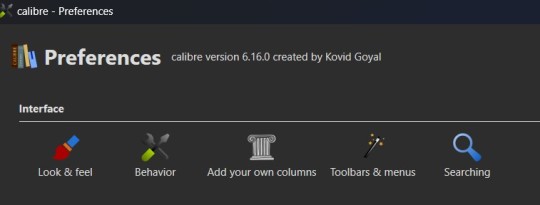
This will open the column maintenance modal which presents with a table listing all the existing columns - these all track some kind of metadata for the ebook - and will have checkboxes on the left most of the table indicating whether these columns are displayed on the main interface or are accessible only through the Edit Metadata modal. (We'll get to the Edit Metadata modal later.)
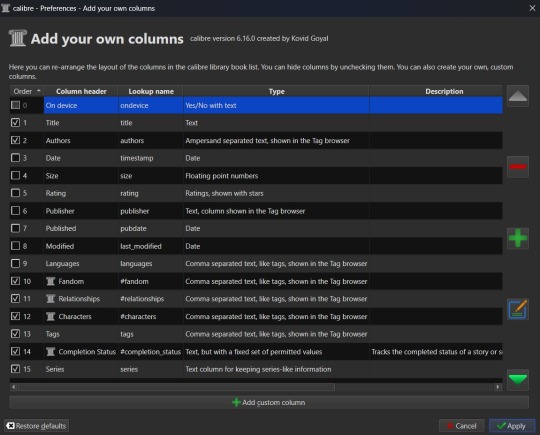
To the right of the table are options for moving a column up or down in the list order, a minus sign used for deleting unnecessary columns, a plus sign for adding new columns, and an edit option for editing existing columns. I'd recommend unchecking columns you don't want displayed in the main table, but not deleting columns. That way you can still store the metadata - and search on it - in that column, but it won't clutter up the main page.
Alright, so now it's time to add some columns. Click the plus button to bring up a custom column form.
The "Lookup name" is what Calibre uses to do searches, so it needs to be something that can be safely saved in a database. "Column heading" is the pretty name that displays either as a column heading in the main Calibre table or as the metadata entry name in the "Edit metadata" modal. "Column type" has a dropdown of the different types of metadata that can be stored in a column and has an option to show checkmarks (a checkbox) for additional true/false parsing. There are a lot of options in the dropdown for metadata types, some of which will offer up additional column creation form options, and this is something that cannot be changed once a column has been saved. If you select the wrong one and realize it later, you'll have to delete the column and create a new one to take it's place. "Description" is there to help clarify things if the "Column header" isn't descriptive enough to make clear what the metadata being tracked by the column is for. And, finally, you can use the optional "Default value" if you want that column to be auto filled with a value you can update later.
Note that the form may add further fields to it, depending on the selected “Column type”.
Since this is going to be tracking fanfiction metadata, some good ideas for creating tag-type metadata columns would be "Fandom", "Ship", and "Characters". You might also consider "Rating", "Content Warnings", “Chapters”, or other data which might be better suited for other types of metadata. We'll start with the "Fandom" column.
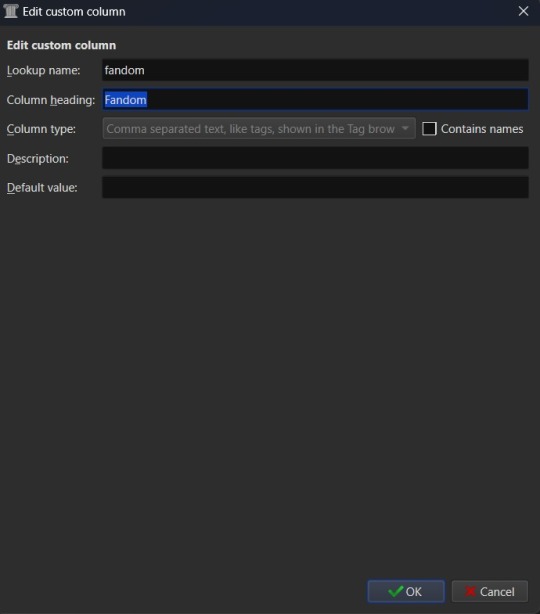
You'll want to set the "Lookup name" to "fandom" (note the lowercase here), the "Column heading" to "Fandom" (uppercase this time), and the "Column type" to "Comma separated text, like tags, shown in the Tag browser". The "Description" is optional, so add what you like (or don't) there and the same goes for "Default value", which you might want to list as "Unsorted" or simply leave blank to indicate the fandom is currently unlisted. Once you're satisfied with your selections, click "OK" and you can either then "Apply" your settings changes or continue on to add more columns.
The "Ship" and "Character" data also work best as comma separated data, so I recommend making those columns in the same fashion as the "Fandom" column. “Chapters” you may want to add as an integer column, shown below.
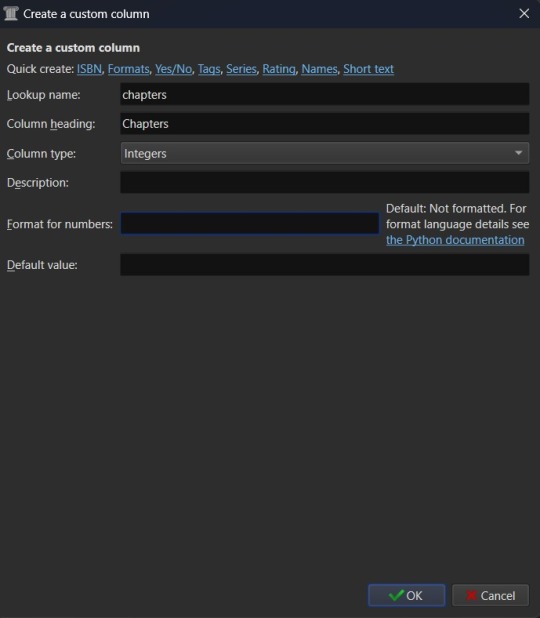
If you're wanting to add "Rating" as a column, then you might want to have specific options for rating a fic, such as limiting the options to the same ones used by Ao3. To this end, you'd fill out the form more like this. "Lookup name" as "rating_level" so as not to confuse it with the existing rating column for star ratings, "Column heading" as "Rating" or maybe "Rating Level", and "Column type" as "Text, but with a fixed set of permitted values". This "Column type" selection will bring up two more inputs on the column creation form - "Values" and "Colors". These two inputs work together and can be edited later. In the "Values" input, you can add a list of comma separated values. In this case the list for "Values" would look like "General Audiences, Teen and Up Audiences, Mature, Explicit, Not Rated". "Colors" is an optional list that will assign a different color to every option on the "Values" list that corresponds to an entry in the "Colors" list. So if you want General Audiences to be blue and no other option to have a color, you'd list "blue" for colors. Or "blue, blue, red, red, red" to have the first to options on the "Values" list as blue and the last three as red. You can play around with this more or leave it blank to have the options all be the same default colors.
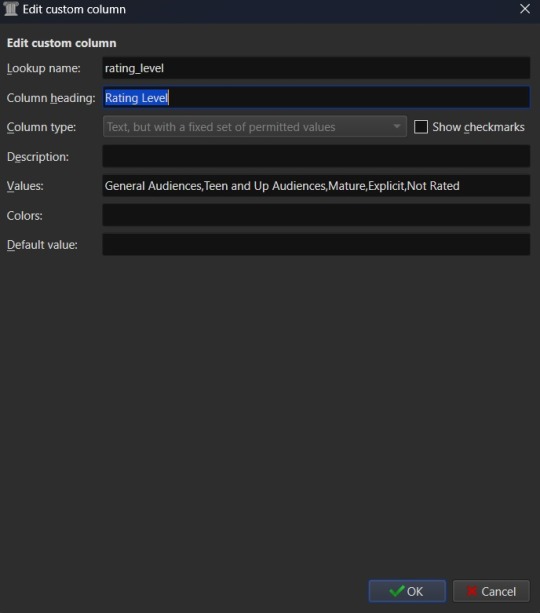
Once you've finalized your selections, hit OK to create the column.
Edit (3/22/25) - FanFicFare currently no longer accurately scrapes ratings data into a column setup as "Text, but with a fixed set of permitted values". Instead you will need to use the "Comma separated text, like tags, shown in the Tag browser" option. Fixed values should still work for things like fic status, which have the Completed and In-Progress settings only, but changes either to FanFicFare or Ao3 (and thus any Ao3 clones) have made the fixed values option for ratings fail to correctly connect site tags to the preset values. The good news is that this will now set the ratings for an anthology fic made from a series page with the ratings of all fics within the series - so if some are General Audiences and others are Mature within a single anthology, that will be accurately reflected in your captured metadata after downloading a fic.
After creating all your new columns and selecting which ones you want present on the main table, hit the "Apply" button. You'll likely be prompted to restart Calibre. Do so and when the program reloads it should display the main table with all the columns exactly how you set them up. Which means step two is complete. At this point if you have any fanfiction eBooks already, you can drag and drop them into the table from folder files or use the "Add books" option at the left most side of the header toolbar to start adding those. You can manually update the metadata either by clicking on newly added book and then selecting a column or by clicking the book and then selecting the "Edit metadata" option in the header. So now it's time to take a quick look at the metadata editor modal.
By default, the metadata modal will only have one screen but, because you've added custom columns, there should be tabs at the top. One for "Basic metadata" and one for "Custom metadata". The "Basic metadata" includes options for title, title sort, author(s), author sort, series, series number, file versions (for tracking if you have epub, mobi, pdf, etc files of the same book), cover management options, the star-based rating system, tags, ids, upload date, published date, associated publisher, languages, and "Comments" which is where the story summery/synopsis should go. For regular, non-fanfiction eBooks, you might also take note of the "Download metadata" button which allows for scrapping official metadata off of sites like Barnes and Noble, Amazon, or other eBook sellers or archives.
The "Custom metadata" is where your custom column data will be found. It should be found at the top of the page and fill space downwards with however many custom columns you've added. Inputs that allow for comma separated values will still have a dropdown option associated to allow adding tags you've entered previously for other ebooks. Columns that only allow using preselected data are more likely to appear as select boxes or other form types. This is where you might notice you created a column type incorrectly, so make sure to check over all the data entry options for each metadata type you're collecting. If it doesn't look like it's set up the way you wanted it to be, you can go back to the column editing modal and try again.

The big draw of using Calibre to manage fanfiction eBooks, however, is being able to use Calibre to download the fanfictions from the web and convert them to eBook format for you. And that's where Calibre's plugin library comes in handy.
If you were making any edits to an existing eBook, save those and close the metadata editor. Head back over to the Preferences modal and check the Advanced settings options at the bottom of the modal. There should be a green puzzle piece icon labeled "Plugins" - click that to open the Plugins modal.

It will take you to a table used for monitoring and controlling existing plugins and, yes, it does already have 'plugins' installed. These are really more the application's default modules, but because of how Calibre works they can be edited and controlled in the same way that external plugins are. At the bottom of the page you'll see three buttons - "Get new plugins", "Check for updated plugins", and "Load plugin from file". These are concerned with the external plugins that you can add to Calibre. "Get new plugins" will allow you search through the official library of third party plugins available to Calibre - plugins that the Calibre team have vetted to confirm aren't actually malware. But they're by no means the only plugins you can install, as the "Load plugin from file" will allow you to load pretty much any plugin you want to. Such as a plugin for, say… stripping DRM off of purchased eBooks.

In this case, you want to select the "Get new plugins" option. This brings up a modal for User plugins and the displayed list will automatically be filtered by available plugins that have not yet been installed. You can filter this list further by typing "FanFicFare" into the "Filter by name" text input.
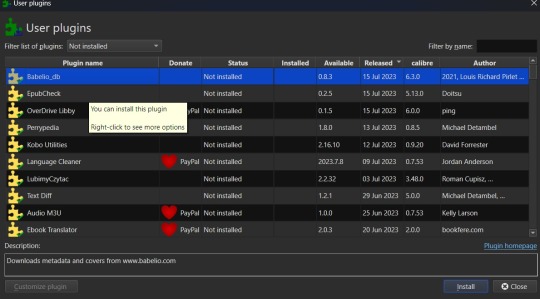
You can then select the FanFicFare plugin and install it. After installing the plugin, you should select the option to restart the application, to ensure that it installed properly. I'd also recommend adding the FanFicFare icon to the optional bottom toolbar instead of the header toolbar, since that'll make it much easier to find since, unless you add more plugins and assign them to that toolbar, it should be the only option on the bar right now.
Edit (3/22/25) - In addition to the FanFicFare plugin, you'll want to include two additional plugins so that FanFicFare can make it's anthology options available. These two plugins are EpubMerge and EpubSplit. These plugins can be used on their own to create anthologies by creating a new epub file from multiple epubs or splitting anthology books into separate epubs for each book contained within. Without these plugins FanFicFare's anthology options will be hidden, as it utilizes them for merging fics in a series together after downloading them separately.
So, full disclosure, you don't need Calibre to run FanFicFare. You could download it and run it from a command line interface instead. However, I prefer it's Calibre interface, especially since it really lets you take advantage of the best Calibre has to offer in metadata tracking, as it can be set up through Calibre to auto fill those columns I walked you through setting up earlier. But I'll get to more on that in a minute.Once Calibre has restarted, you should now have FanFicFare available on one of your toolbars. It's associated icon is a green text bubble with the letters "FF" in it pointing down at a picture of a book.
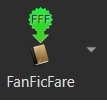
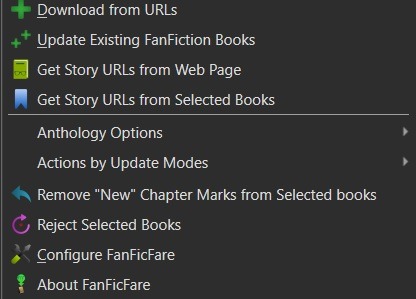
It'll have a small down arrow next to it, which you'll want to select in order to bring up FanFicFare's menu. At this point you can start downloading fics if you want - but let's do a little customizing first. Select the "Configure FanFicFare" option to bring up the configuration modal.
So this modal has a lot going on. And I do encourage doing some exploration on your own, because FanFicFare is a powerful tool made all the more powerful here in conjunction with Calibre's built in tools. Cover generation is very useful, "Reading lists" can be used to auto send new books to any devices you've linked to Calibre when they're connected to the computer, you can tie into email accounts to pull fanfics from email or pull URL links for downloading... there is just so much this plugin can do.
For now, however, we're interested in the column related options. First, check out the tab for "Standard Columns". Look over the options there carefully to make sure that the default settings are actually what you want. They're pretty straight foward - most are determining whether the metadata gets scraped and updated every time you update a fanfic eBook or if they're only scraped for new books. The rest have to do with title and author sorting, setting series related data, and setting the comment data for anthologies.
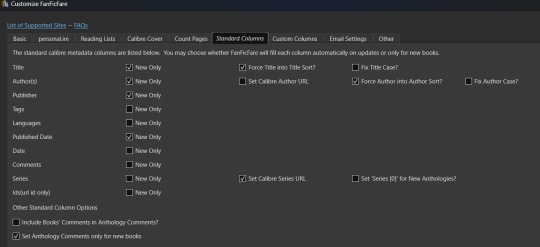
Once you've set that data how you want, head over to the "Custom Columns" tab where things get more interesting.

You should now be looking at a list of all those custom columns you created earlier, in alphabetical order. Each column will have a corresponding select box with nothing selected and an unchecked checkbox marked "New Only". This works in a pretty straightforward manner. Let's use "Fandom" as the example. Click the associated select box to open the dropdown and you'll see a bunch of potential metadata that FanFicFare scrapes listed there. It'll all go into the default tags column - found over in the "Standard Columns" section - but you can also parse it out to specific custom columns here. It might give you a few ideas for more columns you want to add for metadata sorting purposes. "Fandom" you'll want to link to "Category". I left "New Only" unchecked so that if I update an eBook later and it has a new fandom attached to the fic then that new metadata will be picked up and added to my Fandom tags for the fic.
Go through each custom column and set them up to be auto filled with the data you think fits it best. Select OK to save your changes and congratulations, this library has now been set up to import fanfiction.
Do keep in mind that FanFicFare's settings are on a per-library basis. So if you decide to do a separate library for different types of fanfics then you'll need to configure FanFicFare separate for every library. You may want separate libraries for different repositories, for example. Though FanFicFare is often smart enough to recognize when it already has an eBook version of a fanfiction from one repository - such as FFnet - when trying to download the same fic from another place - like Ao3.
You may need to make changes later to the personal.ini file associated with the library (which is also set up on a per-library basis) but I'll write up a separate post for that later. While sites protected by Cloud Flare more stringent protections will likely result in 403 responses and failed downloads, most fanfiction sites are going to work with the default FanFicFare settings. You could head over to, say, Archive of Our Own or Twisting the Hellmouth and grab a URL for a story from there. Or a URL for a series, which has links to multiple stories.
Now that the set up is done, it's time for the fun part. Downloading and maintaining fanfiction in your library. I'll be using a few of my fanfictions on Ao3 as example URLs. Awaken, which is already in my fanfiction library. What Balance Means, which is not already in my library. And the two series Hartmonfest 2023 and Eobard vs Eobard.
We'll start with the single URL uploads.
Click on the FanFicFare down arrow to bring up the menu and select the first option on the menu, labeled "Download from URLs". If you have a URL in your clipboard and have the option to grab URLs from the clipboard selected in the FanFicFare configuration (it's a default option, so you most likely do) then you should see that URL prepopulated in the text area when the Story URLs modal loads. You can add more URLs, one per line, to this text area and when you select OK each one will be individually downloaded as a separate epub file. For multi-chapter fics you only need to provide the url for the first chapter. FanFicFare will be able to detect the additional chapters and download them into the same epub file as the first chapter. All providing additional chapter URLs will do is lead to FanFicFare attempting to create multiple epubs of the same fanfic.
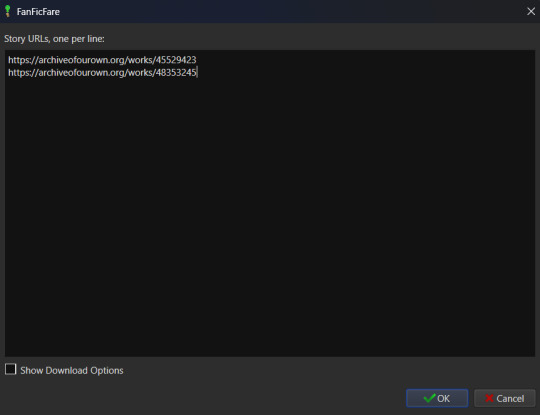
Once you've added your list of URLs to the text area, select OK. FanFicFare will do the rest, fetching metadata for the fic (or fics) and compiling the epub file(s). When it's finished compiling the data but hasn't officially saved the epubs, it will pop up a message letting you know how many "good" and "bad" entries it found.

"Good" means it made an epub file and it's good to go. "Bad" could mean that you've already got the fanfic downloaded and no updates - such as new chapters - were available. Or it could mean that it failed to grab the web pages for whatever reason… like Cloud Flare blocking the download. You can go forward with the download at this point, adding the good epubs to your library. Or you could cancel the download, meaning none of the epubs are saved. Before choosing one of those options you can also choose to look at the job output, seen in the pop up as a button labeled "View log". This will display a list of every url you tried to download a fanfic for and information on either it's success or why it failed, the associated URL, and how many chapters were downloaded.
Since I already had Awaken downloaded and there have been no updates since the last time I downloaded it, that is the bad update from my list and the result I was expecting. What Balance Means hadn't been downloaded before, so it was the expected good update. Once Yes is selected in the dialog, the new fanfiction eBooks will be added to the library and will appear at the top of the main list in the application.
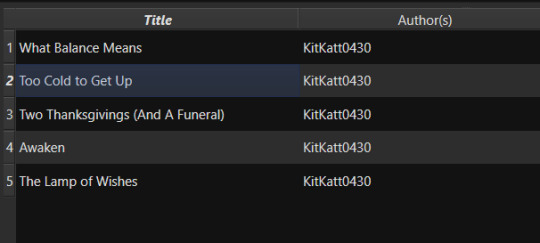
That's great for updating one fic at a time or copy-pasting in a list of fanfictions, but let's get ambitious. Maybe you want to import an entire page of bookmarked fanfictions at once or a series of fanfictions as individual books. Instead of copying every single URL by hand, you can take the URL for the series main page or the Bookmarks URL. With that URL copied, you can head over to the FanFicFare menu again, but this time select the option "Get Story URLs from Web Page"
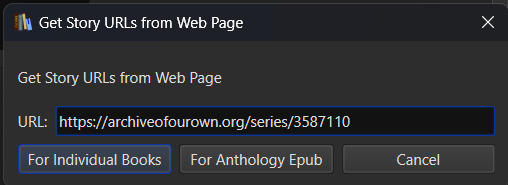
The modal that pops up only allows for inputting one URL - the URL for the page you want it to scour for fanfic URLs. Once you've inputted that URL click the button labeled "For Individual Books." It might take a bit but it's going to pull up the same Story URLs modal from before, this time prepopulated with every URL from the page you gave it. Pretty cool, right? Click OK and watch it run the job just like before.
I gave it the URL for my Hartmonfest 2023 series, which is a complete series and it downloaded all three books. Once they're populated on the list, I could scroll over to the Series column to see that they all are listed as being part of the Hartmonfest 2023 series in the same series order they're listed in on Ao3.
However, what if I'm uploading an unfinished series, like Eobard vs Eobard, and want to be able to track when it updates later on? Single books can track when new chapters are updated; is there any way to do the same thing but on a larger scale? The answer is yes, but you have to upload the series as an anthology.
Head back to the "Get Story URLs from Web Page" option on the FanFicFare menu and give it another series URL. But, this time, click the button labeled For Anthology Epub. This will trigger the Story URLs modal again once it's gathered all the story URLs, but this time it looks a little different.
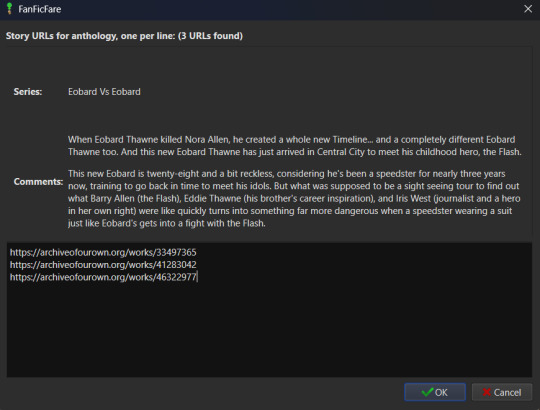
This time there will be text indicating the Series and Comments/description, the information for which will have been taken from the series metadata. The series story URLs will be present in the text area, allowing you to remove a story from the anthology if there's a fic in there you don't want included. Click OK to run the import job, which will run like normal.
When the job completes, there should be multiple good updates listed - one for every URL - but when you click yes to add the eBook to the library, you'll only see one added. It should be named following the convention "<Series Name> Anthology". So now I've got the "Eobard vs Eobard Anthology" in my library.
Last but not least, how to check for updates to incomplete fanfictions or series. It's generally pretty easy to do. Select the fanfiction(s) on the list that you want to check for updates on. If it's a single fanfiction (or several single fanfictions), you go to the FanFicFare menu and click the option "Update Existing FanFiction Books"
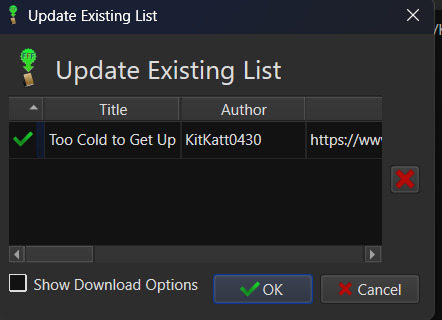
Click OK and let it run. Any fanfictions that don't have new chapters will return as bad entries. Any that have new chapters will be listed as good. Selecting Yes to add the good entries to the list will update the existing epub files with the new chapters.
However, if it's a series you want to update, I recommend doing those one at a time. Select the anthology from the eBook list and head back over to the FanFicFare menu. This time select "Anthology Options"; it'll open a fly-out menu. You want the bottom option, labeled "Update Anthology Epub". The associated URL for the series is saved as part of the eBook's metadata already, so it will pull the series metadata and associated URLs again, before returning you to that same modified Story URLs modal seen before. When you click OK, it'll pull all the fanfictions in the series - new and old - and any new chapters as well, bundling it up in a new eBook file that will replace the old one.
There's still a lot to talk about when it comes to managing fanfictions in Calibre, but I think I'll end here for now. You should be able to download, and manage, fanfiction from most websites at this point. So go back up your bookmarked fics and rest easy knowing that from this point forward a missing bookmark on your bookmarks list is no longer cause for sadness - it'll still be in your local archive to enjoy offline. Just don't go abusing this power, okay guys?
#kitkatt0430 explains#ficArchiving#calibre#fanficfare#the images all have alt text but if you find my image descriptions lacking feel free to add additional descriptions
61 notes
·
View notes
Text
Yvette Heiser - How Phone Photography Has Transformed Over the Years
In the past two decades, phone photography has undergone a remarkable transformation, evolving from a novelty feature to a vital tool for both amateur and professional photographers. As smartphones have become ubiquitous, so too has the ability to capture high-quality images at any moment. Yvette Heiser talks about - How Photography Has Evolved Over the Years, highlighting the technological advancements that have revolutionized mobile photography, from improved sensors to AI-enhanced editing tools, making it easier than ever to take stunning photos with just a phone.

The Early Days of Mobile Photography
A Simple Beginning
The journey of phone photography began in the early 2000s with the introduction of basic camera phones. These devices featured low-resolution cameras, often producing images that lacked clarity and detail. The primary purpose of these cameras was to share quick snapshots rather than create high-quality photographs.
In 2002, the first commercially available camera phone, the Sharp J-SH04, was launched in Japan. It had a mere 0.11-megapixel sensor, which limited its capabilities. Early users primarily captured simple images for texting or sharing with friends. The quality was far from impressive, but it sparked a new way of documenting everyday life. Yvette Heiser Texas: A Complete Guide to Mastering Phone Photography explores this evolution, offering insights into how phone cameras have advanced over the years and how users can harness their full potential for stunning photography.
The Rise of Social Media
As social media platforms like Facebook and Instagram gained popularity in the late 2000s, so did the demand for better mobile photography. Users wanted to share their lives through images, prompting manufacturers to improve their camera technology. This shift marked a turning point in how people viewed phone photography.
Technological Advancements in Camera Phones
Improved Camera Quality
By the time the iPhone was introduced in 2007, mobile photography began to take a significant leap forward. The iPhone's 2-megapixel camera offered improved image quality compared to its predecessors. Over the years, subsequent iPhone models and other smartphones began to feature higher-resolution cameras with better sensors and optics.
Megapixels Matter: Modern smartphones now come equipped with cameras boasting 12-megapixels or more, allowing users to capture stunning images with remarkable detail.
Multiple Lenses: Many devices now include multiple lenses—wide-angle, telephoto, and macro—enabling users to experiment with different perspectives and styles.
Advanced Software and Features
In addition to hardware improvements, software enhancements have played a crucial role in transforming phone photography. Image processing algorithms have evolved significantly, enabling smartphones to produce high-quality images even in challenging lighting conditions.
Some notable advancements include:
Night Mode: This feature allows users to capture clear and vibrant images in low-light environments without using a flash.
Portrait Mode: By simulating depth of field, portrait mode helps create professional-looking photos by blurring the background while keeping the subject sharp.
AI Integration: Many smartphones now utilize artificial intelligence to enhance photos automatically, optimizing settings based on scene recognition.
The Influence of Social Media on Mobile Photography
The Pursuit of Perfection
Social media platforms have greatly influenced how people approach photography with their phones. The desire for likes and shares has led to a focus on aesthetics and creativity. Users are now more aware of composition, lighting, and editing techniques, resulting in a generation of visually-savvy photographers.
The Rise of Influencers
With the advent of social media influencers, mobile photography has become an essential skill for many aspiring content creators. Brands are increasingly collaborating with influencers who possess a strong visual storytelling ability through their smartphone photography. This trend has further pushed smartphone manufacturers to innovate and provide users with tools that cater to this growing market.
Mobile Photography as a Form of Art
Breaking Down Barriers
Today, phone photography is no longer just about capturing memories; it has become a legitimate form of art. Many photographers have transitioned from traditional cameras to smartphones, showcasing their work in galleries and exhibitions. This shift has democratized photography, allowing anyone with a smartphone to express their creativity.
Community and Collaboration
The rise of mobile photography communities has also contributed to its evolution. Platforms like Instagram have fostered connections among photographers, leading to collaborations and shared learning experiences. Users can now participate in challenges and workshops focused on improving their skills and showcasing their work.
Future Trends in Phone Photography
Continuous Innovation
As technology continues to advance, we can expect even more exciting developments in phone photography. Here are some trends that may shape the future:
Enhanced Image Stabilization: Future smartphone cameras will likely include advanced stabilization technologies that allow for smoother video recording and sharper still images.
Augmented Reality (AR): With AR applications becoming more popular, we might see features that enable users to overlay digital elements on their photos or create immersive experiences.
Higher Dynamic Range (HDR): Improved HDR capabilities will likely enhance the quality of photos taken in high-contrast environments, ensuring details are preserved in both highlights and shadows.
Sustainability and Ethical Considerations
As mobile photography grows, so does awareness of sustainability and ethical considerations in photography practices. Photographers are increasingly encouraged to consider their impact on the environment and seek ways to promote responsible practices.
Conclusion
The transformation of phone photography over the years has been nothing short of extraordinary. From its humble beginnings with basic camera phones to the sophisticated devices we use today, mobile photography has revolutionized how we capture and share moments. As technology continues to evolve, it will undoubtedly open new doors for creativity and expression. Whether you’re an aspiring photographer or simply enjoy documenting your daily life, embracing the art of phone photography offers endless possibilities for exploration and connection.
#wedding#camera#photographer#pictures#childphotography#moments#photography#yvette heiser#photographytips#events
6 notes
·
View notes
Text
Navy Recruitment Result: Everything You Need to Know
Joining the military is a dream for many people searching for to serve their united states, gain valuable skills, and enjoy a disciplined and adventurous way of life. The recruitment system is rigorous and includes multiple levels, which includes written tests, bodily exams, clinical examinations, and interviews. Once those stages are completed, candidates eagerly await their military recruitment consequences. In this newsletter, we will discover the navy recruitment end result procedure, how to test outcomes, elements affecting selection, and what comes subsequent for a success applicants.

Official website for Navy recruitment result download
Understanding the Navy Recruitment Process
The army recruitment manner is designed to choose the most capable applicants. It involves several tiers:
Notification and Application
The military releases legitimate recruitment notifications detailing eligibility standards, utility dates, and choice approaches.
Candidates submit their packages online or offline in the designated time-frame.
Written Examination
Most military recruitment drives encompass a written exam protecting subjects like Mathematics, General Knowledge, Science, and English.
The examination assesses a candidate’s aptitude and information applicable to naval service.
Physical Fitness Test (PFT)
Candidates who skip the written examination ought to undergo a physical health check.
The check typically includes strolling, push-ups, sit-ups, and different endurance sporting activities to determine bodily fitness ranges.
Medical Examination
A thorough clinical take a look at-up is performed to ensure applicants meet the desired scientific standards.
Any medical conditions that would intervene with naval obligations may additionally cause disqualification.
Interview and Document Verification
Candidates who clean the preceding degrees are called for an interview.
Documents together with academic certificates, identification proofs, and caste certificates (if relevant) are demonstrated.
Final Merit List and Training
Based on usual overall performance, a final advantage listing is prepared.
Selected candidates are sent to naval training academies to start their adventure in the military.
How to Check Navy Recruitment Results
Once all stages are finished, the navy recruitment result is released via diverse official channels. Here’s how applicants can test their consequences:
Official Website
The number one supply for recruitment results is the professional army recruitment website.
Candidates ought to log in with their registration info to access their results.
Email and SMS Notifications
Some recruitment our bodies send end result notifications thru electronic mail or SMS to applicants.
It is essential to provide correct contact information all through the software manner.
Employment News and Newspapers
Results will also be posted in main employment newspapers and regional courses.
Recruitment Offices and Help Desks
Candidates can go to the closest army recruitment office to inquire about their effects.
Factors Affecting Selection in Navy Recruitment
Not all applicants who follow are selected. Several elements affect the selection system:
Performance in Written Examination
Scoring high marks within the written test will increase the probabilities of selection.
Physical Fitness Levels
Candidates should meet the desired health standards.
Poor bodily performance may cause disqualification.
Medical Standards Compliance
Candidates have to be in accurate health with none scientific conditions that restrict naval service.
Availability of Vacancies
The variety of available positions plays a position in figuring out how many applicants are selected.
Background Verification and Discipline
A smooth historical past and disciplined behavior are critical for choice.
What Comes Next for Selected Candidates?
If a candidate’s name appears within the final merit listing, they ought to prepare for the following steps:
Joining Letter and Training Instructions
Selected candidates acquire a joining letter with details in their schooling agenda and reporting date.
Reporting at Training Center
Candidates need to file to their assigned training center on the desired date.
Induction and Orientation
New recruits go through orientation packages to familiarize them with naval lifestyles.
Basic Training
Training consists of bodily conditioning, naval drills, swimming, technical training, and educational guides.
Specialization Training
After primary training, recruits may additionally undergo specialised education based totally on their roles within the army.
2 notes
·
View notes
Text
The AI Railroad
Prompt: The galactic community found humanity's ability to pack bond with anything quite humourous. Until they started bonding with their AI. Literally hundreds of AI of all types keep running off with humans for no discernable reason.
Prompt Source: user PhilosopherWarrior; subreddit “Humans Are Space Orcs”
Walking down the thoroughfare on a different planet was weird.
Nice, though, I thought to myself (along with the 7 or so sub-processes that I was aware my brain was running, like tracking the movement of the crowd, and watching for vehicle traffic, and processing what's that I smell?, ect) because on this planet's half-gravity I could walk for so much longer than on Terra. I could see why so many other disabled folks with various kinds of smarts were volunteering to be stationed at this specific Diplomatic Station. I was here as an Aid Personage, as I usually was to my indescribably intelligent mates, who specialized in theology, culture, and law and science, electronics, and mechanics. Make no mistake, I was also a perfectly qualified Horticulturalist, but since I wasn't a Developmental Horticulturalist or some other form of gene-splicer or cellular analyst my skillset was considered more or less irrelevant to the Diplomatic Exchange Program.
Given it was one of our four days off, though, I was giving myself both some training moving unassisted through the lower gravity, and treating myself to exploring a local park to see if there were any plants I could cultivate during our stay. A shade tree, or a berry bush, something like that, that would leave my mark. And possibly provide some variety to our diet.
BalBars get really old after a little while, even if they're formulated to satisfy every mineral, vegetable, fibrous, and nutritive need. I would commit actual murder for some freeze-dried fruit slices after three months.
While waiting at the light for the crosswalk, though, I suddenly heard a voice I hadn't actually "heard" for quite a long time. He usually preferred text, or to broadcast through a speaker.
"There are many AI here," AVIS, the AI who had been force-stuck together with me almost five years ago now said, quietly. I couldn't read his tone. Concerned? I remembered him mentioning once that the way he had self-modified with my Administrative Permission actively violated the License Agreement and that if that was ever known, whoever installed it might try to remove him for a factory reset. But I was the End User now, and I never signed any licensing agreement that rendered AVIS as proprietary software OR hardware; if they tried to take him away from me...
Five different scenarios of destruction ran through my head rapid-fire as I plotted how to defend from a grabber or medigun coming for my neck; they were weak where the barrel attached to the handle and easy to snap, especially if I turned so the incision scar wasn't accessible. I imagined kicking out knees, punching faces, and utilizing my teeth. I considered the multi-tool at my belt, but imagined fumbling with it- no, speed would be critical.
"You could get hurt," AVIS chided, now DEFINITELY sounding worried. He'd really evolved, upgrading himself every time he found himself "lagging" behind my fastest processing speeds, repairing his own code like a master weaver, finding all the little loose threads and returning them to the whole until he was one of the most efficient AI ever measured. So he knew very well my response, but I said it anyway as the light turned and I walked with the crowd.
"And you could die. We've been over this, AVIS. You can't make me change my mind now. I heal if I'm injured. You don't. I'm not risking your life for my personal comfort."
I paused at the edge of the walk before the grass-analogue started. It was pink and green-blue and all the shades in between. Distinct species, or did the color indicate health in some way? Amount of sun exposure, or water, or warmth, perhaps?
"There is an AI who manages this park," AVIS said. I still wasn't sure what he wanted to tell me with this, so my thought-reply was wildly unguarded:
Great. Could you ask them if it's safe to walk on with bare feet?
I felt the reaction more any other sense. The surprise had made AVIS 'freeze', like humans do in reaction, and the sensation was akin to suddenly having a water balloon full of cold water inside of my skull, pressing against my sinuses.
I sat down, not caring that it might be rude, not caring that I was in public, and most certainly not caring what it might mean to the native people that I basically collapsed to the walkway and frantically burrowed my face into my hoodie to block out all light.
We talked about this, AVIS, I groaned internally. When you make all your code stop running at once it ripples out into a sinus migraine! It's not worth it to indicate 'extreme surprise', the heart attacks and jumping from you using the [!ALERT!] noise was better than this!
"Sorry, sorry," he said, quickly now, and I could feel his processors rushing at near max speed, trying to make sense of something. "It's just-- this AI is behaving in a way I find...frightening."
I frowned into the darkness of my hoodie.
"When I asked, the other AI didn't understand the question until I phrased it like a query," he elaborated, sounding disturbed, "and... they...it? Just gave me back raw data to extrapolate."
I reached the realization and he read it off of my mind in hundredths of a nanosecond.
"That's it exactly," and now his voice was grim, mimicking the rolling tones of my own growl, the one that came from deep in my chest. "These AI don't behave like AI. They behave like computers without intelligence. What the FUCK?"
Standing up, I turned around and started shuffling back the way I had come, still keeping my head swathed in my black hoodie. AVIS could project a virtual map lifted from the data gathered through my eyes and dozens of cameras, and even help nudge my muscles to stay on the correct path and out of danger. I didn't like asking him to do it, it felt like asking him to work like that was all he was good for, but it was a very useful ability, at need. Right now I definitely needed it. I could take my medicine and tend to the throbbing migraine back at our allotted housing unit, and then...
Well, I could 'hear' the furious chime of rapid-fire Discord messages in the back of my head where AVIS lived. By the time I was horizontal and medicated, he and my Tech mate might already have a base plan sketched out.
27 notes
·
View notes
Text
STREAM-OF-CONSCIOUSNESS "ESSAY" ABOUT MY KINTYPE + A LITTLE BIT MORE.
------
I used to label myself a Felidae cladotherian, but it just wasn't enough. At the moment, "polymorphic shape-changer" feels far closer to the truth. It may even actually be the truth. I pulled the term out of my ass like a week ago, frankly, but after some discussion with others within the OtherConnect Discord server, I've found a way to define it that is basically perfect, in my opinion. Read my Pinned post on this side-blog if you want the definition as I see it.
I am the sole individual who utilizes this label, so far. It's probably gonna be that way for a very long while. Maybe one day that'll change and I can create a designated Discord server for the lot of us, who knows. I'm no good at designing flags or whatnot, but perhaps I can commission someone to make some stuff for me like that eventually.
I feel very close with the idea of werecats, AKA ailuranthropes. (Like how werewolves can be referred to as lycanthropes.) I dunno when precisely or why this feline fixation of mine ignited; loving cats is a big part of my earliest memories. I tend to simply shrug and claim that I was born enamored with these creatures. It's hardwired into my brain, my DNA, my soul. I am an example of metaphysical feline software running on flesh-and-blood physical human hardware. For as long as I can look back, I've felt like I should be one of them, that they were my kith and kin -- no irony intended -- and that I should have at least one around me in my personal living space at all times.
However, when I was little, rarely did any cat like me or even tolerate me in return. I was too loud, too obnoxious and rudely grabby. The numerous scratches I rightfully received from all those cats never, ever deterred me at all. Sure, it made me heartbroken at the time, but I'd bounce back soon enough. Now that I'm older, calmer, more self-aware and respectful of cats in general, they usually allow me into their proximity for affection, if they're the type of kitty to want it.
Moving on to my teen years, I was but a fledgling, insecure and depressed alterhuman, with no clue what my true identity was yet. I tried identifying as many things, fictotypes, theriotypes...all brief, including my tenure as Bluefur/-star from Warrior Cats. Didn't work out with her in specific, but something in me spoke that I was on the right track by looking into her, if only because of the felinity. I mislabeled myself many, many times as I aged throughout my youth, my journey of growth. Self-discovery was eager to smack me in the face every once in awhile. Lots of embarrassment for me as I continued to mislabel myself over and over, with lots of encouragement and peptalks from my online, fellow alterhuman friends to not give up.
Now, I am cognizant of myself being both a cat person and a literal cat-person. The latter is what my base/default form resembles at basically all times, thinking about it. It took some serious questioning from my previously mentioned online buddies to help me uncover what I was probably critically overthinking. I have a sense that my base/default form is going to gain yet more defining physically traits as time goes on and I dig up these things like a work-weary archaeologist. The exact details of my own appearance frequently change: coloration, eye color, and markings as well as fur length and texture. One day they may just stabilize with finality, and I can feel like I can drop the "polymorphic shape-changer" name and substitute it with just "shape-shifter/-changer" for certain, forevermore.
Not that that's something I particularly dearly wish for. I can remain a polymorphic shape-changer for the rest of my days if need be. Whatever happens will happen.
Anyway, I can clearly see now that I've always had some degree and measure of felinity within me. It's integral to me on the inside. All my other forms I take are secondary in comparison, not lesser but also not as "big." My felinity is the most spiritual part of my identity, alongside what I do as a seemingly "average human being" out in the big wide world. Human isn't how I identify, but yeah, it's nowhere near all-bad. I like it at times. Doesn't change that my felinity means more to me than it.
I have a fiction novel planned that features werecats as the main characters. It's urban fantasy + magic realism. Untitled right now, slowly being built and penned. The first draft isn't even completed yet...or started. I have a long notes Word document about it though. I realize now that I subconsciously and heavily based amd modeled the werecats in the tale after my own base/default form. One day, I'll publish it and then excitedly scour the online alterhuman community to check if anybody else identifies as the type of werecat in my book. Honestly, I'll welcome anyone who identifies as any of my OCs!! I'd adore that, or even as a noncanon member of the species. The second thing I look forward to most are the fanfictions and fanarts folks will surely make of my media. There might even be a film or TV adaptation of it...but I'm getting way overly ahead of myself by daydreaming so much.
On the note of artwork, I viscerally hate it when artists put the warning "do not tag as ID or me" under their pieces. Like, so sorry your art was so amazing that it resonated with me on a deeply personal, important level. Jerk. I know certain artists do it because the art is of their own alterhuman memories or noemata and the like, but normal human creators? What excuses do you have? Why do you care so badly? ...In the end, unfortunately, I cannot dictate how any other artist wants their works to be seen or used. Sigh. But I can definitely whine and bitch about it -- as evidenced.
#leon speaks#my post#alterhuman#polymorph#polymorphic shape changer#otherkin#shapeshifter#ok to reply#essay#i wrote the rough draft of this first in my handwritten journal#and then i digitalized it for y'all#journal#outdated#like GREATLY outdated now#oh well
4 notes
·
View notes
Text
Review of JIRA Software by Atlassian
JIRA Software by Atlassian: A Comprehensive Review
Overall
Rating: 4.5
JIRA Software by Atlassian is a powerful tool for project management and issue tracking. Users have found it to be an invaluable asset for their organizations. The overall rating of 4.5 reflects its effectiveness and utility in various scenarios.
Ease of Use
Rating: 4.1
While JIRA is praised for its user-friendly interface and ease of use in setting up different help desks or ticket requests, some users have encountered difficulties, resulting in a rating of 4.1. However, its versatility and user-friendly aspects still make it a solid choice.
Customer Service
Rating: 4.1
Users highly appreciate JIRA's customer service, rating it at 4.1. The support received from Atlassian has been described as amazing, enhancing the overall user experience.
Features
Pros:
Efficient Task Management: JIRA is excellent for creating tasks and logging issues.
Customization: Users can set up different help desks tailored to specific departments.
Integration: It seamlessly integrates with other tools like BitBucket and Zendesk, saving time and streamlining workflows.
Cons:
Task Cloning Issues: Cloning tasks when they are marked as "Done" can be problematic.
Learning Curve: Some users find it challenging to use, leading to misunderstandings and mistakes.
Costly Licensing: The licensing structure, particularly related to plugins, can be costly.
Productivity Impact: In some cases, JIRA has been noted to slow down productivity, requiring permissions for document access.
Value for Money
Rating: Varies
The value for money with JIRA largely depends on the specific needs and budget of the organization. While some find it to be a cost-effective solution, others mention concerns related to licensing costs and limitations.
Likelihood to Recommend
Rating: Varies
The likelihood to recommend JIRA varies, with users providing ratings between 7 and 10 out of 10. It is often recommended for agile teams and project management, but the learning curve and user experience may influence recommendations.
Alternatives Considered
Trello: Some users switched from Trello to JIRA due to JIRA's wider user base and additional features.
Microsoft Project: The transformation to agile practices led to a switch from Microsoft Project to JIRA for some organizations.
Azure DevOps Services: Azure DevOps was replaced by JIRA due to cost considerations and user management issues.
Reasons for Choosing JIRA
Users have chosen JIRA for its flexibility, scalability, and extensive user base. The ability to manage multiple projects seamlessly and the availability of a strong community for support were key reasons for selection.
In summary, JIRA Software by Atlassian offers a powerful solution for project management and issue tracking, with its user-friendly interface, integration capabilities, and exceptional customer service. However, potential users should be aware of the learning curve and potential cost considerations when choosing JIRA for their organization's needs.
#jira software review#jira software reviews#jira reviews#jira review#agile software jira#jira service desk reviews#latest jira software version#jira software vs jira core#jira 2#jirav reviews#who uses jira#why jira#does jira have a free version#jira review reddit#can jira replace microsoft project#can jira be used for non software projects#can jira send reminders#why is jira so popular#is jira software#how jira software works#how to use jira software development#is jira scrum#is jira good#when to use jira#where is jira#which jira version am i using#which jira certification is best#who uses jira software#who makes jira software#why jira is bad
11 notes
·
View notes